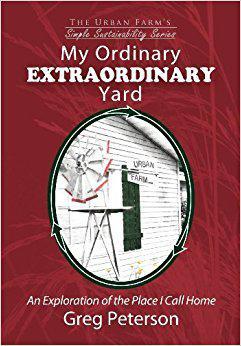The (Very) Brief Guide to Industrial Agriculture
By Emily Powell
We spend a lot of time here at Urban Farm U talking about growing our own food in local, small-scale agriculture. But what’s the deal with our national agricultural industry, anyways? How does it work? Why is it the way it is? Well, I know I don’t have all the answers, but I’m here to provide enough thought-provoking information to encourage you to go learn more about the industry that lies behind our grocery stores and global commodity trade. To start, let me point out that almost HALF of all the landmass in the United States (about 1.2 billion acres) is dedicated to agriculture (meaning it’s used for growing crop or raising livestock). This is mostly broken down into a few huge cash crops:
To start, let me point out that almost HALF of all the landmass in the United States (about 1.2 billion acres) is dedicated to agriculture (meaning it’s used for growing crop or raising livestock). This is mostly broken down into a few huge cash crops:
- Corn: about 90 million acres
- Soybeans: about 84 million acres
- Wheat: about 50 million acres
- For reference, vegetables (aka food we can directly consume): about 4.5 million acres (1/20th the amount of land used to grow corn!!)
These cash crops (corn, soy, wheat) that dominate our landscape are grown to be traded in an international commodity market. In fact, we export about half of all soy and wheat grown in the U.S. and about 20% of all corn. These crops are mostly processed and turned into other products, such as feed for cattle, soybean oil, and flour – not sold for human consumption. Yep, you read right. Most of the crops grown in the U.S. are not directly eaten.
It didn’t used to be like this. Before 1950, farms used to be much smaller and more focused on growing food to supply a local demand for sustenance. The industrial, monoculturing model of agriculture emerged around the middle of the 1900’s, when technology, irrigation, fertilizer and pesticide technologies exploded with innovation and skyrocketed yields more than twelve-fold for farms in developed and developing countries. This market created an incentive for trading in the diverse, local, traditional agricultural model of bygone days for a massive, corporate monster churning out millions of bushels of the most useful crops in order to leverage new economies of scale. In this way, agriculture shifted from nourishment-focused to market-focused, and local agriculture supplying fresh fruits and vegetables suddenly could not make enough money to stay afloat.
Nowadays, farms and farmlands are the money-makers and risk-absorbers of large-scale conglomerates which compete in a global commodity crop market that’s so complex, I won’t attempt to understand or explain it. It’s a market that does more than define how expensive ethanol, soy products, and wheat flour are. It sustains the economic vitality of industries, regions, and countries; it contributes an immense amount of energy consumption and atmospheric carbon to humanity’s ecological footprint; and it’s wildly volatile. Trade agreements such as those established by NAFTA, success of crops in other countries, and subsidies provided by the federal government for certain crops influence global prices and farm incomes. It’s this wonky cycle of feedbacks that’s vitally important when examining the creation and the perpetuation of our international food system. How can we address the economic structure of the agricultural industry in order to create a more sustainable international food system? Does the answer lie in this modern, seemingly never-ending industrialized agriculture? Possibly. It’s up to us to find out.
Cool Sources
- Checkout this website for tons and tons of info and date from the USDA about agriculture and its local and international markets.
- This interesting document from the Census Bureau shows stats and figures about Farm and Farmlands Highlights.
 Emily’s exuberant passion for sustainability and sustainable nutrition stems from her everlasting love for the outdoors, people, dirt, and broccoli. As an undergraduate in the School of Sustainability at Arizona State University, Emily is working towards becoming a spokesperson for everyday sustainable food and lifestyle choices, including decisions on what foods you buy, where you buy them, and how you make the most of foods’ energy. Leveraging communication through writing, Emily has been recognized in competitions such as the DuPont Challenge and the Apprentice Ecologist Initiative for her essays on sustainability issues and initiatives, including Honeybee Colony Collapse Disorder and community gardens in elementary schools. Emily aspires to utilize relationships with other academic disciplines to plant the seeds of sustainability and nutrition principles in the young adults of her generation. She plans to earn her Registered Dietitian credential and work either on the community or personalized sustainable nutrition level.
Emily’s exuberant passion for sustainability and sustainable nutrition stems from her everlasting love for the outdoors, people, dirt, and broccoli. As an undergraduate in the School of Sustainability at Arizona State University, Emily is working towards becoming a spokesperson for everyday sustainable food and lifestyle choices, including decisions on what foods you buy, where you buy them, and how you make the most of foods’ energy. Leveraging communication through writing, Emily has been recognized in competitions such as the DuPont Challenge and the Apprentice Ecologist Initiative for her essays on sustainability issues and initiatives, including Honeybee Colony Collapse Disorder and community gardens in elementary schools. Emily aspires to utilize relationships with other academic disciplines to plant the seeds of sustainability and nutrition principles in the young adults of her generation. She plans to earn her Registered Dietitian credential and work either on the community or personalized sustainable nutrition level.
*Disclosure:
Some of the links in our podcast show notes and blog posts are affiliate links and if you go through them to make a purchase, we will earn a nominal commission at no cost to you. We offer links to items recommended by our podcast guests and guest writers as a service to our audience and these items are not selected because of the commission we receive from your purchases. We know the decision is yours, and whether you decide to buy something is completely up to you.







